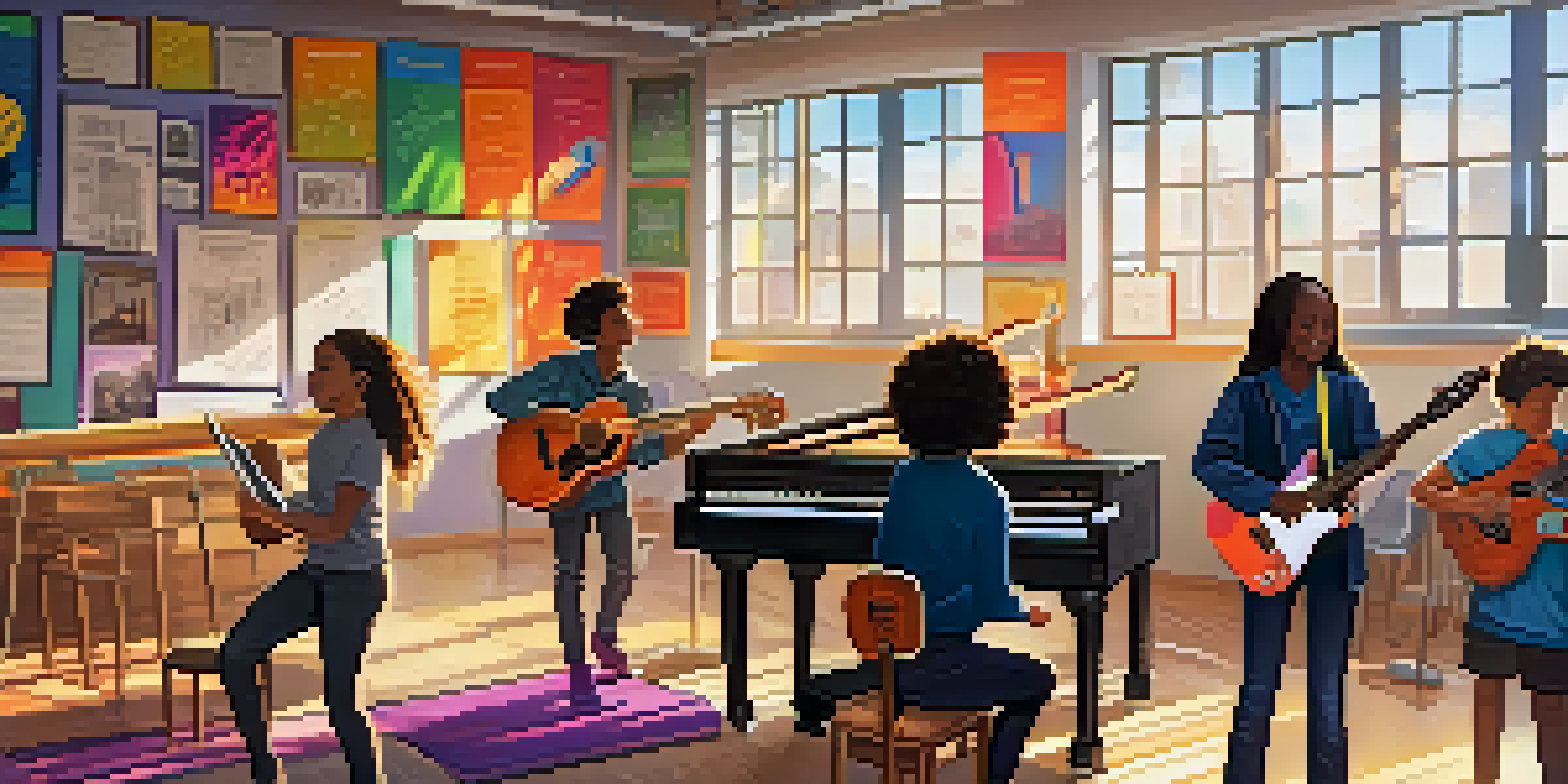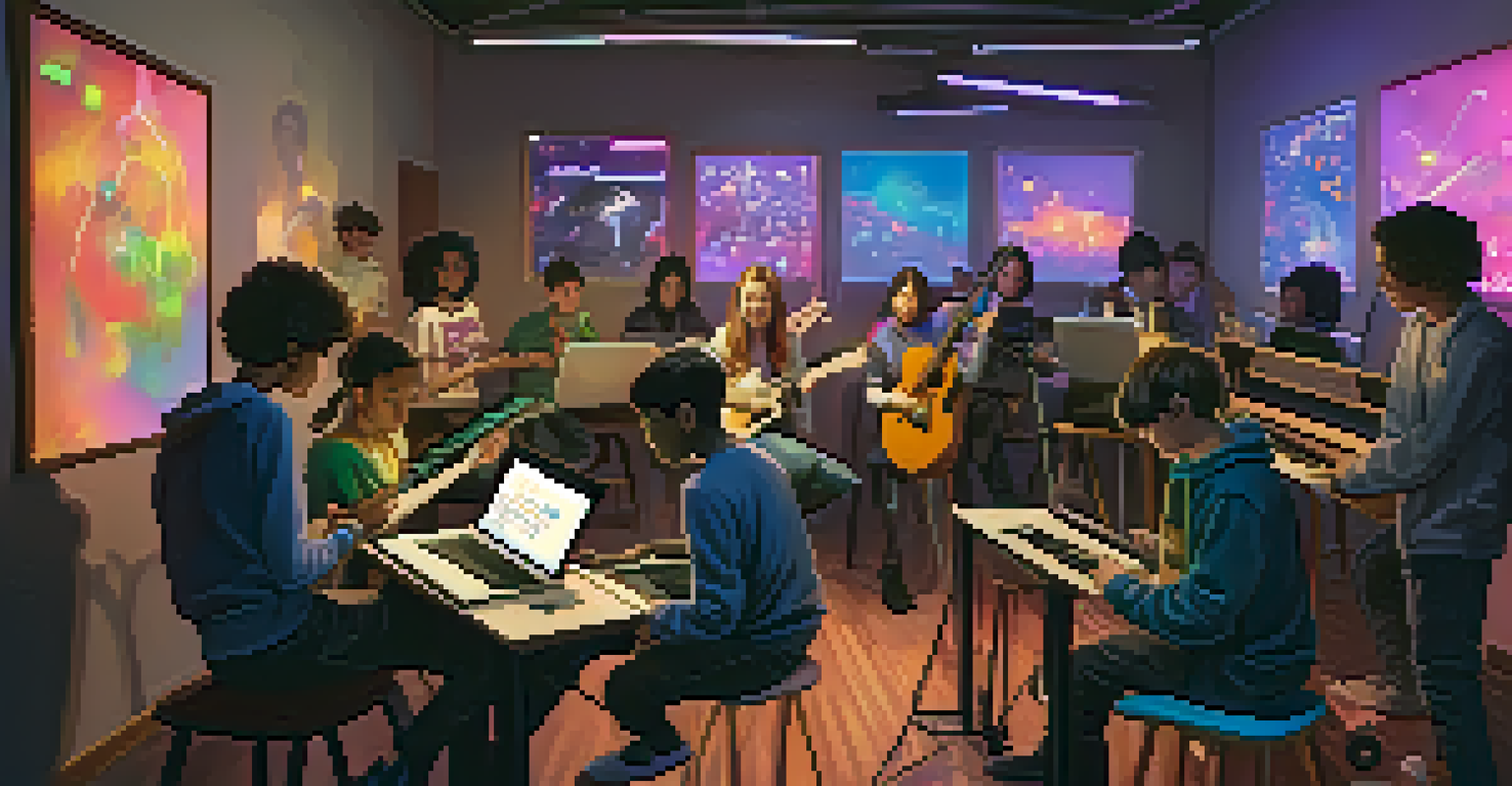The Influence of Streaming Services on Music Education Trends

The Rise of Streaming Services and Their Popularity
Streaming services like Spotify and Apple Music have revolutionized how we consume music. They offer vast libraries at our fingertips, allowing listeners to explore genres and artists they might never have encountered otherwise. This accessibility has not only changed casual listening habits but has also influenced how music is taught in educational settings.
Music can change the world because it can change people.
For instance, students can now instantly access a wide range of musical styles, from classical to contemporary, which encourages them to diversify their listening habits. This exposure can inspire creativity and broaden their understanding of different musical techniques and traditions. As a result, educators are adapting their curriculums to include these diverse influences.
Moreover, the social aspect of streaming platforms, such as sharing playlists and collaborating on music, fosters a sense of community among students. This engagement can lead to collaborative projects, where students learn not just from their teachers but also from each other, enhancing the overall educational experience.
Accessibility and Diversity in Music Education
One of the most significant benefits of streaming services is their ability to make music education more accessible. Students from various backgrounds can access the same resources, regardless of their geographical location or economic status. This democratization of music learning helps to level the playing field in education.

Additionally, streaming platforms provide a treasure trove of diverse music from around the world. This exposure to different cultures and styles encourages students to appreciate and understand global music traditions, fostering a more inclusive approach to music education. Teachers can incorporate these elements into their lessons, enriching the curriculum.
Streaming Services Enhance Learning
Streaming platforms provide students with diverse musical resources that make music education more accessible and engaging.
As students explore various genres and artists, they also develop critical listening skills. This ability to analyze and appreciate different musical components prepares them for more advanced studies and enhances their overall musical proficiency.
The Role of Music Apps in Learning Instruments
In the digital age, learning an instrument has become more interactive and engaging, thanks to streaming services and music apps. Many platforms offer tutorials, backing tracks, and even virtual lessons, allowing students to learn at their own pace. This flexibility is particularly beneficial for those who may not have access to traditional music lessons.
The beautiful thing about learning is that no one can take it away from you.
Moreover, many apps are designed to be gamified, making practice feel less like a chore and more like a fun activity. This approach can motivate students to spend more time honing their skills, leading to faster progress and increased confidence. The integration of technology into music education opens doors for creative expression as students experiment with different sounds and styles.
As students use these tools to learn their instruments, they can also share their progress on social media or streaming platforms, fostering a sense of achievement and community. This shared experience can encourage collaboration and peer feedback, making the learning process even more enjoyable.
Influence of Playlists on Learning Preferences
Playlists have become an essential part of how we experience music, and this trend extends to music education. Educators are beginning to curate playlists that align with their teaching goals, providing students with a structured yet diverse listening experience. These playlists can highlight specific techniques, genres, or historical contexts, enhancing the learning process.
Additionally, students can create their own playlists as part of assignments, allowing them to explore their musical preferences and showcase their unique tastes. This personalized approach to learning can foster a deeper connection to the material, making it more relatable and engaging for students.
Collaboration in Music Education
These platforms facilitate global networking and collaboration among students, enriching their learning experience and skill development.
Furthermore, playlists can serve as valuable study tools. For instance, students might create a calming playlist for practice sessions or a motivational mix before performances, helping them to develop a more tailored approach to their learning and self-expression.
Collaboration and Networking Through Streaming Platforms
Streaming services have not only transformed music consumption but have also opened new avenues for collaboration among budding musicians. Students can easily connect with peers from around the world, share their work, and collaborate on projects without geographical constraints. This global networking is a game-changer for music education.
Moreover, many platforms allow users to upload their original compositions or covers, giving students a platform to showcase their talents. This exposure can lead to feedback from a broader audience, helping them to refine their skills and gain confidence in their musical abilities. The potential for collaboration is virtually limitless.
As students engage in these collaborative projects, they learn essential skills such as teamwork, communication, and adaptability. These experiences not only enrich their music education but also prepare them for future careers in an increasingly interconnected world.
Adapting Teaching Methods to Digital Trends
As streaming services influence music education, educators are evolving their teaching methods to incorporate digital trends. Traditional approaches are being supplemented with technology-driven strategies that resonate with today's students. This shift allows for a more dynamic and engaging learning environment.
For example, teachers might use video analysis to help students understand their performances better. By reviewing recordings from streaming platforms, students can identify areas for improvement and set specific goals for their development. This self-reflection fosters a growth mindset, encouraging students to take ownership of their learning.
Adapting to Digital Trends
Educators are evolving their teaching methods to incorporate technology and streaming trends, making learning more relevant and impactful.
Additionally, educators are exploring ways to integrate social media and streaming platforms into their lessons. Whether it’s analyzing popular songs or discussing trends in music consumption, these discussions help students connect their education to the real world, making learning more relevant and impactful.
Challenges and Considerations in Music Education
While the influence of streaming services on music education is largely positive, it does come with certain challenges. One primary concern is the overwhelming amount of content available, which can make it difficult for students to focus on their learning goals. Educators must guide students in navigating these resources effectively.
Another challenge is the potential for students to rely too heavily on streaming platforms for their music education. While technology can be a powerful tool, it should complement traditional learning methods rather than replace them. Educators must strike a balance to ensure students develop a well-rounded musical foundation.

Finally, as streaming services continue to evolve, educators must stay informed about industry trends and adapt their curriculums accordingly. This ongoing professional development is crucial for equipping students with the skills they need to thrive in a rapidly changing musical landscape.